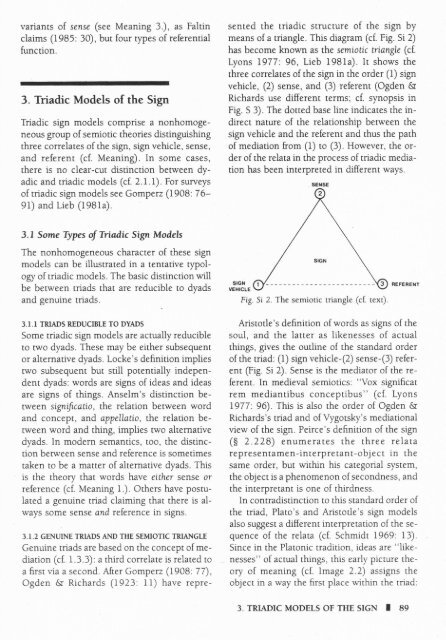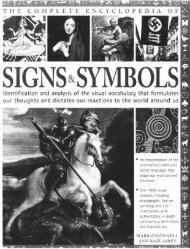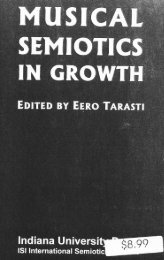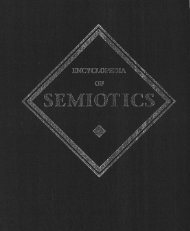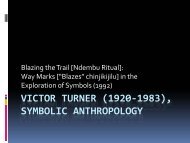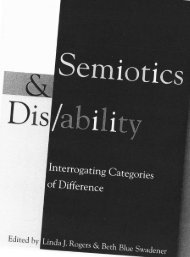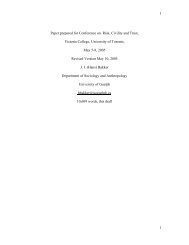Handbook of Semiotics by Winfried Noth - SemioticSigns.com
Handbook of Semiotics by Winfried Noth - SemioticSigns.com
Handbook of Semiotics by Winfried Noth - SemioticSigns.com
You also want an ePaper? Increase the reach of your titles
YUMPU automatically turns print PDFs into web optimized ePapers that Google loves.
variants <strong>of</strong> sense (seeMeaning 3.), as Faltin<br />
claims (1985: 30), butfour tlpes <strong>of</strong> referential<br />
function.<br />
3. Ttiadic Models <strong>of</strong> the Sign<br />
Triadic sign models <strong>com</strong>prise a nonhomogeneous<br />
group <strong>of</strong> semiotic theories distinguishing<br />
three correlates <strong>of</strong>the sign, sign vehicle, sense,<br />
and referent (cf. Meaning). ln some cases,<br />
there is no clear-cut disdnction between dyadic<br />
and triadic models (cf. 2.1.1). For surveys<br />
<strong>of</strong> triadic sign models see Gomperz (f 908: 76-<br />
9I) and Lieb (l98la).<br />
3.I.2 GENUINE TRIADS AND THE SEMIOTIC TRIANGLE<br />
Genuine triads are based on the concept <strong>of</strong> mediation<br />
(cf. I.3.3): a third correlate is related to<br />
a first via a second. After Gomperz (1908 77),<br />
Ogden & Richards (1923: I l) have represented<br />
the triadic structure <strong>of</strong> the sign <strong>by</strong><br />
means <strong>of</strong> a triangle. This diagram (cf. Fig. Si 2)<br />
has be<strong>com</strong>e known as the semiotic triangle (cf.<br />
Lyons 1977: 96, Lieb l98fa). It shows the<br />
three correlates <strong>of</strong>the sign in the order (I) sign<br />
vehicle, (2) sense, and (3) referent (Ogden &<br />
Richards use different terms, cf. synopsis in<br />
Fig. S 3). The domed base line indicates the indirect<br />
nature <strong>of</strong> the relationship between the<br />
sign vehicle and the referent and thus the path<br />
<strong>of</strong> mediation from (l) to (3). However, the order<br />
<strong>of</strong> the relata in the process <strong>of</strong> triadic mediation<br />
has been interpreted in different ways.<br />
3.7 Some Types <strong>of</strong> Triailic Sign Moilek<br />
The nonhomogeneous character <strong>of</strong> these sign<br />
models can be illustrated in a tentative typology<br />
<strong>of</strong> triadic models. The basic disdncdon will<br />
be berween triads that are reducible to dyads<br />
and genuine triads.<br />
3.I.T TRIADS REDUCIBLE TO DYADS<br />
Some riadic sign models are actually reducible<br />
to rwo dyads. These may be either subsequent<br />
or alternative dyads. Locke's definition implies<br />
two subsequent but still potentially independent<br />
dyads: words are signs <strong>of</strong> ideas and ideas<br />
are signs <strong>of</strong> things. Anselm's distinction between<br />
signlf catio, the relation between word<br />
and concept, and appellatio, the relation benveen<br />
word and thing, implies two alternative<br />
dyads. In modem semantics, too, the distinction<br />
between sense and reference is sometimes<br />
taken to be a matter <strong>of</strong> alternative dyads. This<br />
is the theory that words have either sense or<br />
reference (cf. Meaning I.). Others have postulated<br />
a genuine triad claiming that there is always<br />
some sense and reference in signs.<br />
SIGN<br />
VEXICLE<br />
Fio 5i 2. The semiotic triangle (cf. text).<br />
REFERENT<br />
Aristotle's definition <strong>of</strong> words as signs <strong>of</strong> the<br />
soul, and the latter as likenesses <strong>of</strong> actual<br />
things, gives the outline <strong>of</strong> the standard order<br />
<strong>of</strong>the triad: (l) signvehicle-(2) sense-(3) referent<br />
(Fig. Si 2). Sense is the mediator o[ the referent.<br />
ln medieval semiotics: "Vox significat<br />
rem mediantibus conceptibus" (cf. Lyons<br />
1977: 96). This is also the order <strong>of</strong> Ogden &<br />
Richards's triad and <strong>of</strong> Vygotsky's mediational<br />
view <strong>of</strong> the sign. Peirce's definition <strong>of</strong> the sign<br />
($ 2.228) enumerates the three relata<br />
representamen-interpretant-object in the<br />
same order, but within his categorial system,<br />
the object is a phenomenon <strong>of</strong>secondness, and<br />
the interpretant is one <strong>of</strong> thirdness.<br />
In contradistinction to this smndard order <strong>of</strong><br />
the triad, Plato's and Aristotle's sign models<br />
also suggest a different interpretation <strong>of</strong> the sequence<br />
<strong>of</strong> the relata (cf. Schmidt 1969: I3).<br />
Since in the Platonic radition, ideas are "likenesses"<br />
<strong>of</strong> acual things, this early picture theory<br />
<strong>of</strong> meaning (cf. Image 2.2) assigns the<br />
object in a way the first place within the triad:<br />
3. TRIADIC MODELS OF THE SIGN I 89


